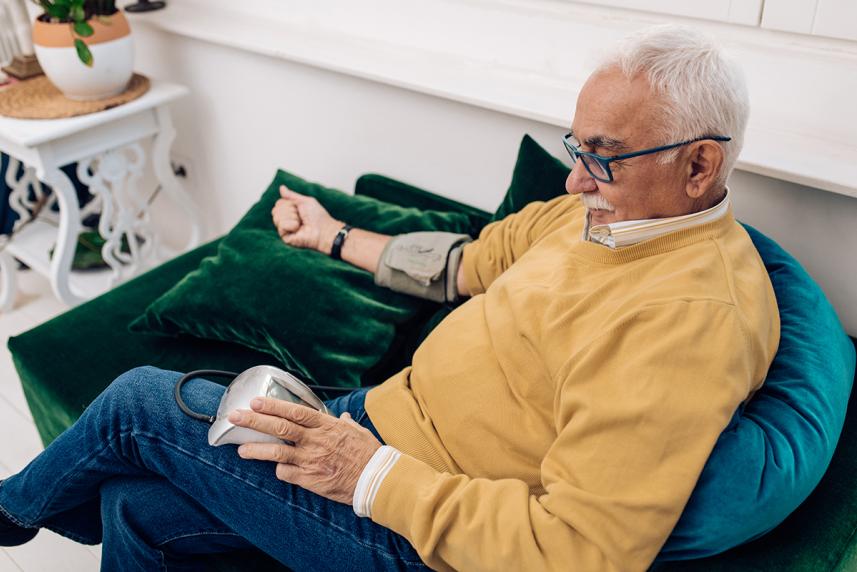
We have you covered — schedule a virtual visit today. No insurance required.

Most definitely if you have any of these conditions. Here’s what to know about these OTC devices and how to pick a good one.
High blood pressure has been called the silent killer, and with good reason. When the force of blood flowing through your blood vessels is constantly high, your heart and blood vessels have to work harder. Over time, that can raise the risk of heart and kidney failure, heart attacks and strokes.
Nearly half of American adults have high blood pressure, according to the American Heart Association (AHA).
The best way to know your pressure is to check it. That’s what your doctor does at every well visit. If your doctor thinks your blood pressure needs to be watched more often, it’s time to get an over-the-counter (OTC) home blood pressure monitor.
Having a monitor at home is convenient. “It’s a great way to be able to take charge of your health care and just be more informed about what kind of numbers you should be getting,” says Aesha Patel, DO. She’s a family medicine doctor at Nuvance Health in New Canaan, Connecticut.
Read on to find out who needs a home blood pressure device, how it works and how to get the most accurate readings.
The AHA recommends this device for people with high blood pressure or pregnant people who have pregnancy-induced hypertension and/or preeclampsia. But people with other conditions can benefit from home blood pressure monitors, too. Here are the 3 most common reasons to own one:
You’re pregnant. During pregnancy, you can develop preeclampsia, a serious condition that can affect your kidneys and can be fatal, says Dr. Patel. OB-GYNs screen women for high blood pressure at every visit, even when they have no history of the condition in their family. With a home monitor, you can check your blood pressure between prenatal visits.
How often to check it: Whenever you have symptoms such as a headache or swelling in your legs or you just feel off, says Dr. Patel.

We have you covered — schedule a virtual visit today. No insurance required.
Your blood pressure is elevated or high. Taking your blood pressure at home can help prevent a stroke or a trip to the ER. There are several reasons for this:
How often to check it: Once a day if you’re on a new medication or getting it adjusted, or if your doctor needs to monitor your pressure, says Dr. Boling. Or more frequently if your doctor recommends it. You should do this for 2 weeks. “If you’re on medication and pretty stable, checking your blood pressure once or twice a week is fine,” she adds.
You have heart disease. This includes coronary artery disease and arrhythmias such as atrial fibrillation. A lot of the medications that people take for heart disease also tend to be medications that affect blood pressure, Dr. Patel says. One side effect of these medications: Your blood pressure gets too low, which can make you dizzy or pass out.
How often to check it: Once a day for the first 2 weeks if you’re on a new medication or getting it adjusted. Or if you have signs of low or high blood pressure, such as dizziness, headaches, blurry vision or feeling off, says Dr. Patel.
Never worry about missing a refill again. The Optum Store can manage your prescription and have it mailed to you. Get started.
There are 2 numbers in a blood pressure reading. The top number (aka systolic) is the amount of pressure that’s exerted when your heart is pushing out blood. The bottom number (known as diastolic) is the amount of pressure against your vessels when the heart is at rest, explains Dr. Boling.
When the top number is over 129 and the lower one higher than 79, your blood pressure is high.
To get better readings when you take your blood pressure, follow these doctor-approved tips.
Take your medication first (if you’re on one). Doctors base your need for a new dose or medication on the blood pressure readings you get after you take your pills, Dr. Boling explains.
Relax. Take your blood pressure when you’re fairly relaxed, says Dr. Boling. Anxiety and stress can raise your blood pressure. Don’t use the device right after you’ve come into the house, exercised or had a cup of coffee. All those things elevate your blood pressure.
Sit down for the reading. “Both feet should be on the ground, and your legs shouldn’t be crossed,” says Dr. Boling.
Keep your arm elevated. The arm wearing the monitor needs to be elevated to around heart-level. If you’re sitting at the kitchen table, put your arm on the table. If you’re on a chair, rest it on the chair's arm or a pillow.
Wear a T-shirt. It’s best to have the monitor rest against your skin instead of a sweater or shirt, so a T-shirt is ideal.
There’s no need to spend a lot. Check for the following features:
If you have questions about how to use your home blood pressure device, take it to the doctor’s office, says Dr. Boling. Your doctor can check to see how you’re using it.
You can find a variety of blood pressure monitors at the Optum Store. Shop now.
Additional sources
High blood pressure statistic: American Heart Association (2017). “The Facts About High Blood Pressure”
Monitor advice: American Heart Association (2017). “Monitoring Your Blood Pressure at Home”